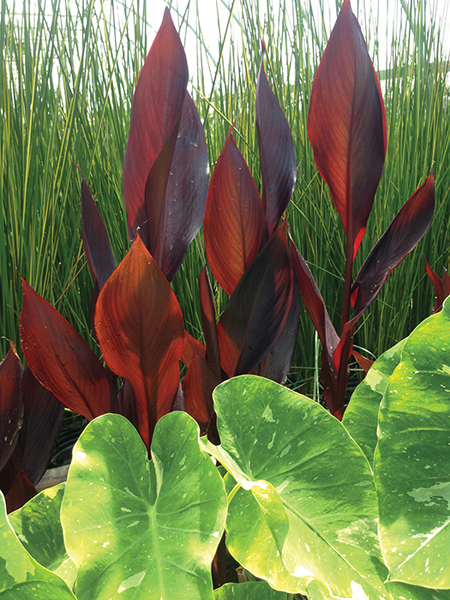
Plants with colored foliage are a luxury, an anomaly, and quite often, just the right splash of color or contrast to make magic happen. There are several ways they can effectively transform a display. Foliage, by any definition, has the ability to shape a landscape with its color, form or shape. Botanically speaking, variegated foliage can be defined as plants marked with patches, spots or stripes of different colors, or as a plants having or consisting of leaves edged or patterned in a second color, especially white and green.
Modern hybridizing techniques are changing the game. The traditional green and white is still as vibrant as ever, but the pallet has expanded substantially. Glowing chartreuse, yellow, cranberry-red, pink, burgundy, purple, orange, black and green in endless shades can blend together in subtle mutations an dramatic color combinations.As evidenced very dramatically by Colocasia (or Taro), foliage color is highly diverse among variegated plants. Some examples seen above include Colocasia esculenta ‘Illustris’, Colocasia esculenta ‘Red Stem’, Colocasia ‘Mojito’, Colocasia ‘Black Magic’, Colocasia ‘Elepaio’, and Colocasia ‘Black Beauty’.
Splashes of Color
Dynamic foliage combinations that carefully consider texture and color can be so effective that this role reversal can render flowering plants secondary in an arrangement. Hakonechloa macra ‘All Gold’ and Colocasia ‘Jet Black Wonder’ are sprinkled with vinca, begonia and petchoa (a petunia-Calibroachoa cross).

A flash of vibrant color (Colocasia ‘Elena’) can be the lighthouse that beckons a visitor closer. It signals in the distance, “Here I am! Come see me!” The variegated Iris laevigata offers just enough color to keep things from being too dark in the midfield view.
In some plants, light and foliage interact to create interesting effects. Colocasia ‘Tea Cup’ holds its leaves upright rather than vertically. The leaves become very large and quite tall. The sunlight illuminates them from the inside, and the dark veins and subtle changes in the greens are exaggerated for added interest.
Many cannas have variegated foliage, but none can compare to Canna ‘Intrigue’. When the sun shines directly on the leaves, they are a mediocre, dusty gray-green with subtle burgundy mixed in.
Cast the light from the side, and they begin to come alive. The green and red become bold, and the contrast is defined. When backlit completely, the leaves are on fire! The transformation is somewhat surreal. If they are planted on the north side of a water feature, the production will be lost. Place these beauties on the east or west side of the pond to see the daily rotation of color, or site them on the south side for a breathtaking mutation of orange, green, burgundy and red. Add a breeze, and the color magically shifts on the leaves as they move.

Make a Statement
A wise man once told me that most people spend more months indoors looking out at their gardens than outside interacting with them. Variegated plants are more effective at making a statement than their green counterparts, especially when they are viewed from a distance. The bright foliage colors are more visible, and therefore better at announcing things like, “Spring is here!”
In a shaded pond, lighter greens, bright yellows and splashes of white can provide focal points and liven up a dim corner. Saururus chinensis tolerates shade, has bright green leaves and throws a bright-white leaf just before blooming. It’s like a glowing surprise.
The variation of color doesn’t end with shallow-water plants. Hardy, tropical and intersubgeneric species of waterlilies offer both subtle and breathtaking combinations of color on their foliage and flowers. More and more new hybrids are making their way to market with exceptional color combinations. Over the past few years, several winners of the International Waterlily and Water Gardening Society’s New Waterlily Competition have had strong variegated foliage and flowers.
Plant With Purpose

When pulling it all together, make certain that the plant combinations are complementary. Too many color splashes can get messy-looking and distract from the focal point. Colored foliage should be used en masse and with purpose to highlight the structural differences of companion plants. Brighten a dark corner, or create a destination at the end of a bridge. Sometimes revealing just a hint of color can be enticing enough to lead you around the bend for a magnificent display.
A great garden starts with a well-executed plan. Create a lasting impression.


